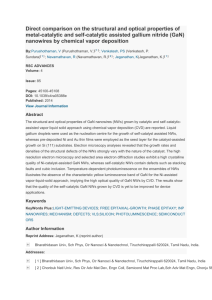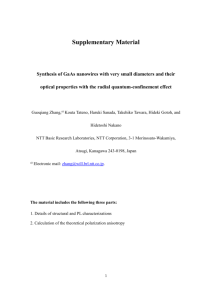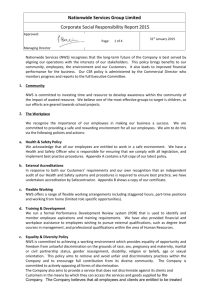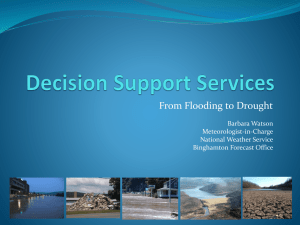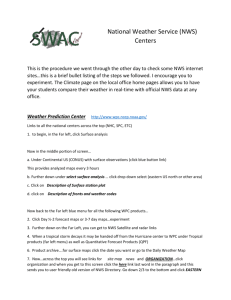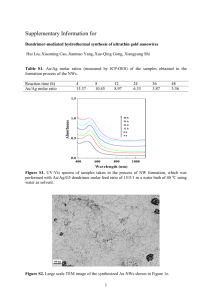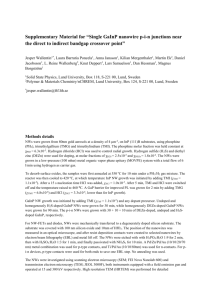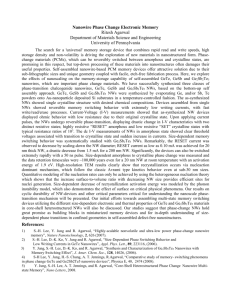Minutes FWWT NWS Nov 16-17 2004
advertisement
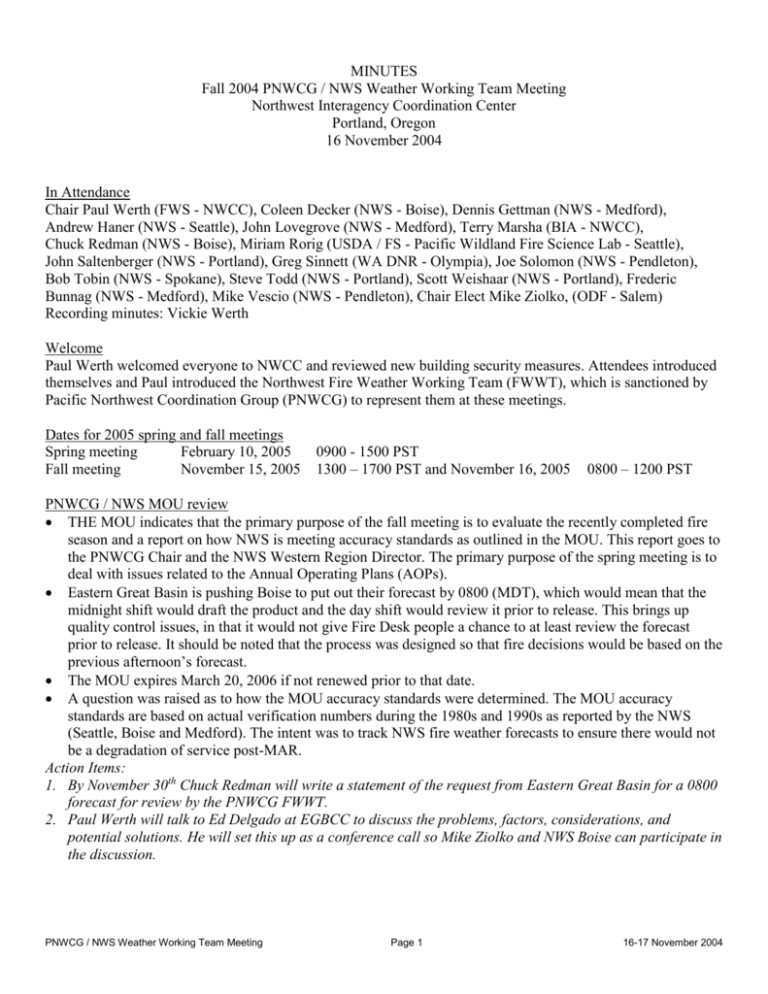
MINUTES Fall 2004 PNWCG / NWS Weather Working Team Meeting Northwest Interagency Coordination Center Portland, Oregon 16 November 2004 In Attendance Chair Paul Werth (FWS - NWCC), Coleen Decker (NWS - Boise), Dennis Gettman (NWS - Medford), Andrew Haner (NWS - Seattle), John Lovegrove (NWS - Medford), Terry Marsha (BIA - NWCC), Chuck Redman (NWS - Boise), Miriam Rorig (USDA / FS - Pacific Wildland Fire Science Lab - Seattle), John Saltenberger (NWS - Portland), Greg Sinnett (WA DNR - Olympia), Joe Solomon (NWS - Pendleton), Bob Tobin (NWS - Spokane), Steve Todd (NWS - Portland), Scott Weishaar (NWS - Portland), Frederic Bunnag (NWS - Medford), Mike Vescio (NWS - Pendleton), Chair Elect Mike Ziolko, (ODF - Salem) Recording minutes: Vickie Werth Welcome Paul Werth welcomed everyone to NWCC and reviewed new building security measures. Attendees introduced themselves and Paul introduced the Northwest Fire Weather Working Team (FWWT), which is sanctioned by Pacific Northwest Coordination Group (PNWCG) to represent them at these meetings. Dates for 2005 spring and fall meetings Spring meeting February 10, 2005 Fall meeting November 15, 2005 0900 - 1500 PST 1300 – 1700 PST and November 16, 2005 0800 – 1200 PST PNWCG / NWS MOU review THE MOU indicates that the primary purpose of the fall meeting is to evaluate the recently completed fire season and a report on how NWS is meeting accuracy standards as outlined in the MOU. This report goes to the PNWCG Chair and the NWS Western Region Director. The primary purpose of the spring meeting is to deal with issues related to the Annual Operating Plans (AOPs). Eastern Great Basin is pushing Boise to put out their forecast by 0800 (MDT), which would mean that the midnight shift would draft the product and the day shift would review it prior to release. This brings up quality control issues, in that it would not give Fire Desk people a chance to at least review the forecast prior to release. It should be noted that the process was designed so that fire decisions would be based on the previous afternoon’s forecast. The MOU expires March 20, 2006 if not renewed prior to that date. A question was raised as to how the MOU accuracy standards were determined. The MOU accuracy standards are based on actual verification numbers during the 1980s and 1990s as reported by the NWS (Seattle, Boise and Medford). The intent was to track NWS fire weather forecasts to ensure there would not be a degradation of service post-MAR. Action Items: 1. By November 30th Chuck Redman will write a statement of the request from Eastern Great Basin for a 0800 forecast for review by the PNWCG FWWT. 2. Paul Werth will talk to Ed Delgado at EGBCC to discuss the problems, factors, considerations, and potential solutions. He will set this up as a conference call so Mike Ziolko and NWS Boise can participate in the discussion. PNWCG / NWS Weather Working Team Meeting Page 1 16-17 November 2004 Evaluation of NWS services a. Fire weather zone boundary changes An evaluation of the Goldendale area indicates that it correlates more closely with northern Oregon than eastern Washington. Under the proposed boundary change, Goldendale, Wasco Butte, and Middle Mountain would all become part of Zone 609. The proposed change has been approved by SWIC and the Mt. Hood NF, and it has been approved by the PNWCG FWWT. The NWS requires a 120-day waiting period, so it would have to be finalized soon if it was to be in effect by the 2005 fire season. There is a need to establish where the official fire weather zone shape files should reside. Shape files need to be where they are available to everyone, and they need to be consistent. All updates must be communicated to the Western Region NWS, NWCC, ODF and WA DNR. Shape files could reside at NWCC, which has a full-time GIS person. There is a problem with the zone boundary that includes the Siuslaw NF. Since the FWWT sees a problem with making boundary changes every time there is an occasional problem with local areas, and this is not likely to occur often, the FWWT recommends an administrative procedure in the AOP that would direct all spot forecast requests from the Siuslaw NF (including Oregon Dunes NRA) go to Portland. Action Items: 1. Pendleton NWS will issue a public notice regarding the Zone 609 boundary change. The 120-day waiting period will begin effective the date that notice is issued. 2. Mike Ziolko will get information about the Oregon shape file to John Saltenberger for changes to the file. Greg Sinnett will send the Washington shape file to John Saltenberger, who will forward both to the NWS’ Salt Lake Regional Office, attention Roger Lamoni. The PNWCG FWWT will review the revisions at the spring meeting. 3. Terry Marsha will be solely authorized to issue NFDRS weather station numbers for Oregon and Washington. 4. Scott Weishaar and Frederic Bunnag will get with the Siuslaw NF and incorporate direction that spot forecasts for all of the Siuslaw NF and the Oregon Dunes go to Portland in the both Medford’s and Portland’s AOPs. b. Comments from local users Paul Werth categorized comments received from the field. No comments were received from BLM, BIA or the Park Service, and only a few were received from the Forest Service. Paul distributed the results to the group. Some users indicated they want good forecasts for wet and dry lightning, Miriam Rorig’s work on dry lightning verification, Terry Marsha’s work with problem lightning, and Tom Rolinski’s work on precipitable water may serve as a basis for tools that may make a start toward meeting this need. User education is also part of the solution (i.e. dry lightning is rare, particularly in elevated areas). Terry Marsha suggested not concentrating so much on precipitation, but on the fuel dryness forecasts, which would be easier for the forecasters, the users, and everyone involved. Roger Lamoni sent a letter to WFO Portland indicating that we need to establish consistency in terminology used for Red Flag Warnings (RFWs). This is in reference to “Episode” lightning. IMETs are a national resource, so there is no standard for a particular number of IMETs to be assigned to any particular office. Fred (WFO Medford) will clarify this with Grants Pass Dispatch. Concerning updated fire weather forecasts out of Medford, the updated forecast should be printed at 1000 or 1100 when engines come on so the latest forecast is being used rather than the one issued at 0700. All NWS offices should communicate updates to all fire entities in their areas of responsibilities. Bob Tobin is aware of the problem with Spokane’s spot weather forecasts and is working on it. PNWCG / NWS Weather Working Team Meeting Page 2 16-17 November 2004 The observation link to the map website on the Missoula NWS webpage should be back up and running by now. ROMAN and MesoWest are very useful as well. MesoWest has the same information but in a different format. Fred Bunnag is willing to sit down with users to explain use of the NWS radar site offerings. The change in NWS URLs didn’t go smoothly, resulting in delayed spot forecasts at offices using the Billings Spot Program. Surveys can’t be done independently by NWS offices without contracting them out, but offices could standardize questions they would like to ask and submit them to the FWWT to be incorporated into an online survey. Clarification was made by Medford MIC John Lovegrove that NWS surveys can be done with approval. Action Items: 1. Fred Bunnag will clarify with Grants Pass Dispatch that IMETs are a national resource, so there is no standard for a particular number of IMETs to be assigned to any particular office. c. Red Flag Warnings (criteria, terminology, format, verification) The GACC is pretty liberal with verification statistics. The RFW criteria are queried in Terry Marsha’s database. This clearly indicates verified and missed warnings. Paul Werth sent a copy to all offices. If this data does not match NWS statistics, they should contact the GACC so the reason for the discrepancy can be determined. Spokane and Portland returned their comments and Paul incorporated them into his verification stats, resulting in the GACC’s verification figures matching closely with NWS statistics. Seattle will forward their comments to the GACC. There were fewer warnings issued this year due primarily to a milder fire season. Medford issued five warnings this year, but none verified. One dry lightning event was missed though. The low sample size made it difficult to show statistical improvement over the previous year. Pendleton has a unique RFW criteria that includes low daytime RH and poor overnight RH recovery. The problem with this criteria is that it is met all too often. For example, 49 RFWs would have needed to be issued on 17 days this July. Pendleton would like to include wind as a factor, but that would be difficult, so it should probably be dropped. Joe Solomon requested information from the GACC on how often the criteria would have been met, if winds of 10 mph or greater were factored in, but has not yet received a response. Terry Marsha is working on it. Boise is the only office that continues to use the term “forecaster judgment” in their RFW criteria, making verification very difficult. The FWWT would like to see “forecaster judgment” removed from Boise’s RFW criteria, which Boise agreed with. Boise also plans to make their frontal passage criteria more specific. Squaw Peak was out for a while this year and bogus information was being entered into the data system. Sugarloaf shows a lot of improvement in measuring wind, due to it having been moved this past summer. The FWWT indicated that Sugarloaf it is now an excellent wind station. d. General and NFDRS forecasts (verification, AWIPS backup, wind terminology, gusts) The Portland NWS office received requests from the NWS Regional Office, in Salt Lake City, that a consistent definition of dry / episodic lightning be developed. Note that this request came from management, not from the field. This term, which began with Don Carlton’s Cheetah program, will probably become more widely used as time goes on. It is problem lightning in conjunction with dry fuels and 7 to 9 ignitions. Suggestion: Continue to use red flags for dry lightning and change the definition of “lightning after and extended dry period” to “lightning in combination with dry fuels.” (This requires coming up with a specific definition of dry fuels which Terry’s research has already determined.) Generally, introducing new terms is successful only when done gradually and when incorporated into PNWCG / NWS Weather Working Team Meeting Page 3 16-17 November 2004 training. To be most successful, only introduce new terms if the current ones are not working, or introduce them as part of the definition of currently existing terms. Action Items: 1. Terry Marsha will do a query using sustained winds of 10 at night with RH less than 35 and previous afternoon less than 10. Terry will e-mail this information to Joe Solomon as soon as possible, and will bring the results to the spring meeting. 2. Boise will drop “forecaster judgment” from their RFW criteria and their frontal passage criteria will be fine tuned. 3. The term “episodic lightning” will be dropped from this year’s AOPs and, replaced with “lightning in combination with dry fuels”. Dry lightning will be defined as “lightning storms which fail to drop enough rainfall to significantly elevate fuel moisture.” 4. Portland WSO will explore dropping numeric probability forecasts from the afternoon planning forecast and report back at the spring meeting. MM5 dry lightning products and 2004 verification Predicting Dry Lightning Risk in the Western United States A PowerPoint presentation by Miriam Rorig USDA Forest Service - Pacific Wildland Fire Sciences Lab, Pacific Northwest Research Station (PNW) – Seattle, WA They are trying to predict convective days. The study started with a preliminary analysis of Spokane, and then expanded to other areas in the western United States. Means and variances were taken for lightning days at each station to get a single value for the entire western United States. Only fires of at least 100 acres are on the 209s, so the Lightning-Caused Fire graphic does relate to fires of 100 acres and greater. The typical dry lightning 500 mb pattern was shown when the ridgeline is east of Washington and Oregon and there is anti-cyclonic curvature to the flow. Comments / Suggestions The group indicated an interest in having Miriam place a 50 percent line on the Probability of “Dry Lightning” 24-hr predication mapped graphic. They would also like to see precipitable water as another graphic. Paul Werth has a theory that sea surface temperatures off the Oregon and Washington coast affect the wetness or dryness of summer thunderstorms in the Northwest. He is working with Tony Westerling of the Scripps Institute on correlating sea surface temperatures with summer precipitation. It is hard to use BlueSky for smoke management as a site-specific tool. Miriam noted that they have not started doing anything with WRF yet, but they are moving in that direction. The value of the MM5 to IMETs in the field has been increasing each year. The verification this year is excellent, particularly in light of the limited sample size of data this year. It was requested that Miriam consider looking at verification data for 2003 and previous years for which data is available. It was also a suggested that Miriam overlay strike data. Meeting adjourned 1700 PST PNWCG / NWS Weather Working Team Meeting Page 4 16-17 November 2004 MINUTES Fall 2004 PNWCG / NWS Weather Working Team Meeting Northwest Interagency Coordination Center Portland, Oregon 17 November 2004 In Attendance Chair Paul Werth (FWS - NWCC), Coleen Decker (NWS - Boise), Dennis Gettman (NWS, Medford), Andrew Haner (NWS – Seattle), John Lovegrove (NWS, Medford), Terry Marsha (BIA - NWCC), Chuck Redman (NWS - Boise), John Saltenberger (NWS - Portland), Joe Solomon (NWS - Pendleton), Bob Tobin (NWS - Spokane), Steve Todd (NWS - Portland), Scott Weishaar (NWS - Portland), Frederic Bunnag (NWS, Medford), Mike Vescio (NWS Pendleton) Recording minutes: Vickie Werth Evaluation of NWS services (continued from the previous day) d. General and NFDRS forecasts verification) (continued from previous day) Numerical trend forecasts o Most zones have two or three RAWS stations. o 122 days are represented (June 1 through September 30). o There is no useable data for Rover in Medford. o The RAWS verification statistics are derived from three spreadsheets (observed weather, forecast weather, and the statistical comparison of observed and forecast). Data is pulled from WIMS, imported into Excel, and sorted by date. PowerPoint presentation on Weather Trend Verification Paul Werth Boise is the only NWS office that is meeting MOU accuracy standards for temperature and RH. None of the offices are meeting the wind speed standards. Persistence beats the wind speed forecasts at 3of the 6 offices. Note that Boise has a small sample size with only six stations. Chuck Redman and Coleen Decker explained that Boise’s NFDRS point forecasts fall straight from the grids. There were about six days when Boise’s excellent forecasts greatly exceeded persistence. When using discrete values for temperature, it isn’t necessary to wait until 1400 hours for today’s values to come in, which eases the forecaster time crunch in getting the forecast out. Forecast preparation greatly varies between offices, and even within offices. Boise’s internal verification process uses two more stations than those used at the GACC and over a longer period of time (4/28 through 10/20) and subsequently show better improvement for winds than the GACC indicated. Washington DNR is not good at getting information input into WIMS (i.e. weekends, early and late season). This makes it impossible to produce next-day NFDRS forecasts. It is critical that inputting begin by April 1st and continuing through the end of September, even if season-ending events occur earlier than the end of September. In areas where data input into WIMS is accomplished accurately and in a timely manner, it is some of the busiest dispatch centers which are doing the best job of getting their weather observations input on time. The lack of data input could result in greatly increased liability. One of the first things investigators do in fatality investigations is to pull the forecast weather and NFDRS data. Medford discussed the realities of developing forecasts based on 55 stations as opposed to only six. PNWCG / NWS Weather Working Team Meeting Page 5 16-17 November 2004 It may be valuable to throw out stations with bad or bogus data so they don’t affect the rest of the forecast. Ideas for improvement: o Rather than issuing zone trend forecasts, issue single-station forecasts using grid-derived equations for each weather station (i.e. next-day forecast trends applied to current observations, MOS equations). Have forecasters review the results and make necessary edits prior to entry into WIMS. o Use of this single-station forecast technique could significantly increase forecast accuracy. Action Items: 1. Medford will find out whether the Park Service still has Rover operational and find out their plans for it. 2. The FWWT suggested that Medford contact Beth Little, RAWS Coordinator for all of California (out of Redding) with questions about anything in California. NWCC is encouraging Regional Office Fire Managers to establish a full-time RAWS position similar to Beth’s for Oregon and Washington. 3. Seattle will get data to Paul Werth to be incorporated into the GACC verification program for calculating wind speed accuracy over persistence. e. NWS proposed fire weather changes for 2005 There is a proposal which would make Red flag Warning headlines shorter. Action Items: 1. Coleen Decker will e-mail examples of the old format and the proposed format for headlines to Paul Werth for the FWWT. f. Spot forecasts (format, request load) On many occasions the agencies are not providing observations to the WFOs for spot forecasts. WFOs can quote the AOP and require that they meet the requirements or the burner can provide observations from the previous day’s peak burning period. Contract burners are liable for what happens on their burns Action Items: 1. John Saltenberger is teaching the next generation of burners in RX300 classes, so any suggestions for items attendees would like to see emphasized in these classes should be e-mailed to Saltenberger and he will prepare information to be presented at the spring meeting. g. IMET support (dispatch problems, 2004 support in the NW, incident documentation, trainees) Trying to get orders out of ROSS is difficult. Sometimes it takes 72 hours for the actual orders to come through after the initial call. NWCC staff requested they be permitted to treat IMETs as any other resource so, if one isn’t available in their dispatch area, they could immediately go to the nearest available IMET in the Northwest rather than going through Boise first, but that variance in procedure was denied by Boise. Jim Prange sent word that the biggest problem this year was rental vehicles. They may be approved, but expanded dispatch sometimes denies the expenditure. According to the NWCC operations leadership, the request for a rental car must be included on the original order. However, each dispatch team has a finance person who has the final word. Other factors include the fact that many rental companies and contracts do not allow off-road use, which makes them useless for many fire situations. The MOU does state that the agencies will provide vehicles. There was also a problem with computers and cell phones, possibly due to claims against the government for lost or damaged equipment. IMETS need a three-letter unit identifier for their WFO when they check in at an incident. These were provided by the Northwest Coordination Center for all offices except Boise, which needs to contact NICC for Boise’s code. Action Items: 1. Gerry Day and Steve Arasim will bring up the subject of rental vehicles with the National Coordinators’ operations group at their meeting the second week in December. They will recommend that wording in the PNWCG / NWS Weather Working Team Meeting Page 6 16-17 November 2004 MOB guide be changed to indicate that ordering an IMET automatically includes a vehicle request. h. Internet briefings The GACC has not had any complaints about Internet briefings this year. Boise NWS has had a request to provide an open house for instruction on how to follow along with an Internet briefing. It was noted that these briefings are designed for fire decision-makers, not for dispatchers. Sometimes the briefings are too long. Medford records the audio portion of the briefings so that users can view the briefing package at their convenience. 2004 Fire season review (weather and fires) The PowerPoint presentation that would have been presented at this time will be included with the minutes. Action Item: 1. Paul Werth will attach the 2004 Fire Season Review PowerPoint presentation to the minutes. Evaluation of agency-provided weather observations There is a problem with a few units not getting their weather into WIMS in time for the NWS to produce next-day forecasts. A number of stations appear to be suffering from severe wind sheltering from overgrown vegetation. NWS/GACC daily conference call There seems to be a problem with the GACC staff briefing differently than what the IMETs are providing on the fire. This seems to be primarily due to a timing problem (the lack of availability of everyone involved in the telephone conference call early enough to be able to coordinate the information being provided by the GACCs and IMETs). It was noted that all GACC briefings are general and large-scale; they are never site specific. In general, however, the consensus is that the conference calls are one of the most valuable tools available for coordination and they are going quite well, particularly in the short term. There was discussion as to whether the calls should incorporate an overall synopsis of the current situation. Some NWS staff feel that calls are sometimes led strongly, making them reluctant to disagree with the lead. Action Item: 1. Paul Werth will contact Jim Prange to clarify the details of the problem with uncoordinated forecasts on conference calls. 2. John Saltenberger asked that attendees impress upon others in their offices the importance of being aware of short-term and longer-term considerations prior to beginning the conference calls. Program leaders should instruct others in their offices to look at extended forecast information prior to the conference calls. Evaluation of Predictive Service products Dryness Levels by Predictive Service Area (PSA) Verification Presentation Terry Marsha Marsha shared information on 100-hour fuel moistures with forecasted versus observed ERCs. He reviewed his data with the group on the large screen. 1) The E-4 persistence line peak is probably due to the fact that it is the result of one fire season’s data. If using five or six years’ data, that peak would probably not occur. 2) Data is initialized each day using the previous day’s data run through regression equations to determine dryness levels. PNWCG / NWS Weather Working Team Meeting Page 7 16-17 November 2004 A schematic shows the process for determining “Significant Fire” Potential using standardized definitions of “Significant Fire Potential,” “Ignition Triggers,” and “Significant Weather Triggers.” It is done using statistical data. It illustrates how Resource Availability comes into play. This is being developed on a national level for resource allocation. Map types are a strong factor in these equations, as is temperature difference between 700 and 500 mb, and precipitable water. This uses model data provided by the NWS. Ongoing projects John Saltenberger (NWS – Portland OR) Most of the tools below work better using Explorer rather than Netscape. Saltenberger suggested IMETs tap into NCEP MOS Coop data for 10-day maximum and minimum temperatures. The process involves defining queries from the data within an Excel worksheet. The forecaster saves the list and produces the information in two formats, one tabular and the other graphical. He had the tabular format colorize big change days (when there is more than a 10-degree difference between max and min). IMETs can run this in the field if they have Internet access, Windows XP and the latest version of Excel. This is available in a zipped file that has already been tested. Saltenberger also created a graphic he is posted to the web each day indicating the NFDRS Model G observations illustrating the breakdown of individual stations in the various Predictive Service Areas (PSAs). It also shows the data upon which the graphic is based. Another webpage incorporates the NFDRS indices for all RAWS sites. It includes a clickable link to every fire weather zone in the Pacific Northwest, regardless of whether they are based on Model G. A tabular and graphic format for forecasted estimates of ERC and F100 is also available on the website. John Saltenberger displayed a color-coded matrix based on upper air soundings that shows Haines Index values. Saltenberger showed the group the archive of data he has automated a macro to pull each hour. He archived forecasts, graphics from the web, hourly NEXRAD data for each day during the fire season, lightning plotted data, IR 4K Water Vapor and 1K Vis, the NC daily, the daily SIT report, and more. He will distribute to the group a list of everything on a set of six data disks that are currently being replicated for each WFO. Saltenberger is willing to teach IMETs how to set up a scheduler that saves the information with unique file names. Action Item: 1. John Saltenberger will talk to Blanche France about getting the data saved on a DVD rather than several CDs in the future. 2005 Annual Operating Plan Having multiple formats is a nightmare when it comes to compiling the AOP. John Saltenberger has created a master format for 2005 AOPs that will be e-mailed to each fire weather program manager. He also produced a standard set of terrain and fire weather zone maps that will be sent to each program leader. They may use those or other maps as long as they fit the established format. Establishing a standardized table format is the next step in this process. Action Item: 1. Colleen Decker volunteered to help Saltenberger input data for standardizing the AOP. Summary of action items 1. By 30 November 2004 Chuck Redman will write a statement regarding the request from Eastern Great Basin for an 0800 forecast for review by the PNWCG FWWT. 2. Paul Werth will talk to Ed Delgado at EGBCC to discuss the problems, factors, considerations, and potential solutions. He will set this up as a conference call so Mike Ziolko and Boise the NWS fire weather focal point can participate in the discussion. PNWCG / NWS Weather Working Team Meeting Page 8 16-17 November 2004 3. Pendleton NWS will issue a public notice regarding the Zone 609 boundary change. The 120-day waiting period will begin effective the date that notice is issued. 4. Mike Ziolko will get information about the Oregon shape file to John Saltenberger for changes to the file. Greg Sinnett will send the Washington shape file to John Saltenberger, who will forward both to the NWS’ Salt Lake Regional Office, attention Roger Lamoni. The PNWCG FWWT will review the revisions at the spring meeting. 5. Terry Marsha will be solely authorized to issue NFDRS weather station numbers for Oregon and Washington. 6. Scott Weishaar and Frederic Bunnag will get with the Siuslaw NF and incorporate direction that spot forecasts (including the Oregon Dunes NRA) go to Portland in both Medford’s and Portland’s AOPs. 7. Fred Bunnag will clarify with Grants Pass Dispatch that IMETs are a national resource, so there is no standard for a particular number of IMETs to be assigned to any particular office. 8. Terry Marsha will do a query using sustained winds of 10 at night with RH less than 35 and previous afternoon less than 10. Terry will e-mail this information to Joe Solomon as soon as possible, and will bring the results to the spring meeting. 9. Boise will drop “forecaster judgment” from their RFW criteria and their frontal passage criteria will be fine tuned. 10. The term “dry / episodic lightning” will be dropped from this year’s AOPs and, if necessary, incorporated into an explanation of dry lightning. Dry lightning will be defined as “lightning storms which fail to drop enough rainfall to significantly elevate fuel moisture.” 11. Portland WSO will explore dropping numeric probability forecasts from the afternoon planning forecast and report back at the spring meeting. 12. Medford will find out whether the Park Service still has Rover operational and find out their plans for it. 13. The FWWT suggested that Medford contact Beth Little, RAWS Coordinator for all of California (out of Redding) with questions about anything in California. NWCC is encouraging Regional Office Fire Managers to establish a full-time RAWS position similar to Beth’s for Oregon and Washington. 14. Seattle will get data to Paul Werth to be incorporated into the GACC verification program for calculating wind speed accuracy over persistence. 15. Coleen Decker will e-mail examples of the old format and the proposed format for headlines to Paul Werth for the FWWT. 16. John Saltenberger is teaching the next generation of burners in RX300 classes, so any suggestions for items attendees would like to see emphasized in these classes should be e-mailed to Saltenberger and he will prepare information to be presented at the spring meeting. 17. Gerry Day and Steve Arasim will bring up the subject of rental vehicles with the National Coordinators’ operations group at their meeting the second week in December. They will recommend that wording in the MOB guide be changed to indicate that ordering an IMET automatically includes a vehicle request. 18. Paul Werth will attach the 2004 Fire Season Review PowerPoint presentation to the minutes. 19. Paul Werth will contact Jim Prange to clarify the details of the problem with uncoordinated forecasts on conference calls. 20. John Saltenberger asked that attendees impress upon others in their offices the importance of being aware of short-term and longer-term considerations prior to beginning the conference calls. Program leaders should instruct others in their offices to look at extended forecast information prior to the conference calls. 21. John Saltenberger will talk to Blanche France about getting the data saved on a DVD rather than several CDs in the future. 22. Coleen Decker volunteered to help Saltenberger input data for standardizing the AOP. Meeting adjourned 1200 PST PNWCG / NWS Weather Working Team Meeting Page 9 16-17 November 2004
